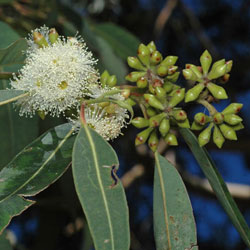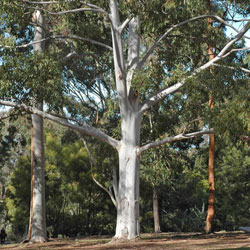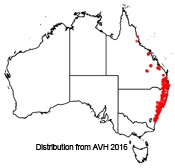Eucalyptus saligna
 |
 |
Sydney Blue Gum
Eucalyptus saligna, commonly known as the Sydney Blue Gum or Blue Gum, belongs to the family Myrtaceae. Its main distribution is along the coast and adjacent ranges from Batemans Bay, New South Wales, up to south-eastern Queensland. The species inhabits tablelands and fertile valleys with well drained soils and can be found growing up to altitudes of 1000m. In the southern parts of its distribution it is found growing in valleys, whereas in the northern parts of its distribution, the species is found growing on high slopes and ridges. It generally grows in areas which receive between 800 to 1200 mm of rainfall in the summer season on either loam or soils of volcanic origin.
This impressive eucalypt is a tall forest tree which can grow to between 30 to 65 m tall. The bark is rough and dark brown-grey in colour at the base, which then extends up into smooth, blue-grey and white bark. The rough bark can cover up to 4 m of the base of the tree trunk before thinning and shedding off the tree in long thin strips.
The juvenile leaves of Eucalyptus saligna are opposite and/or alternate in arrangement, have an ovate to lanceolate shape and are generally 12 cm long and 5 cm wide. The adult leaves of the tree are glossy green, lanceolate to falcate in shape, alternatively arranged, have oil glands and are 16 cm long and 3 cm wide. Both juvenile and adult leaves are discolourous (i.e. the upper and lower surfaces of the leaf are different colours).
The flowers are white and form axillary inflorescences which contain clusters of 7 to 11 flowers. They usually appear between the months of January to April. The fruit are obconical and woody, with the ripe seed available in the months following flowering. Seeds are easily germinated and grown. Care should be taken to select pots that help prevent root-curl.
All eucalypts have an efficient method for shedding limbs, as described by Jacobs (1955). For this reason, larger species such as E. saligna should not be planted so that they will overhang dwellings.
Eucalyptus saligna has an attractive rose-coloured timber which is suitable for commercial production due to its rapid early growth under favourable conditions, as well as its ease to work with. The timber is durable and is used in general construction, flooring, posts, house frames and fuel. The species is moderately frost and drought tolerant.
Eucalyptus saligna can be affected by various diseases and pests. Psyllids belonging to the genus of Spondyliaspis are known to attack natural forests of Eucalyptus saligna. Trees weakened by attack are then more susceptible to other insects such as the wood borer Xyleborus truncatus. Seedling survival in nurseries has been found to be reduced by fungal species such as Pythium and Rhizoctonia.
Isabel Zeil-Rolfe, Volunteer Botanical Training Program Participant 2016
Name meaning: Eucalyptus salignaEucalyptus - from the Greek eu meaning well, and kalyptos meaning covered, alluding to the cap of lid which covers the stamens in the bud saligna - Latin for ‘willow like’ |
References:
Brooker, M.I.H. & Kleinig, D.A. (1999) Field Guide to Eucalyptus Volume 1, South-eastern Australia. 2nd ed. Bloomings Books.
Chippendale, G.M. (1988) Myrtaceae – Eucalyptus, Angophora, Flora of Australia 19, Australian Government Publishing Service, Canberra.
Cremer, K.W (ed.) (1990) Trees for Rural Australia, Inkata Press, Melbourne.
Jacobs, M.R. (1955), Growth habits of the eucalypts. Timber and Forestry Bureau, Canberra.
![An Australian Government Initiative [logo]](/images/austgovt_brown_90px.gif)


